I’m not new to the health wearable trend. Is anyone new to wearables at this point? Between the OG Fitbit, the Apple Watch, and too many other brands to name – there are so many wearables on the market at this point. But because the Amazon Halo is so new – I was only able to buy it “early access” – I’m seeing it’s not so easy to find a solid Amazon Halo review that comes from an individual vs a tech website.
So, that’s what we’re going to do today. I’m not a consumer tech blogger or writer. I’m a pretty average human actually who happens to have a lot of wellness goals that go beyond my step count or weight. I purchased the Amazon Halo with my own money because I was genuinely curious – is the Amazon Halo worth it?
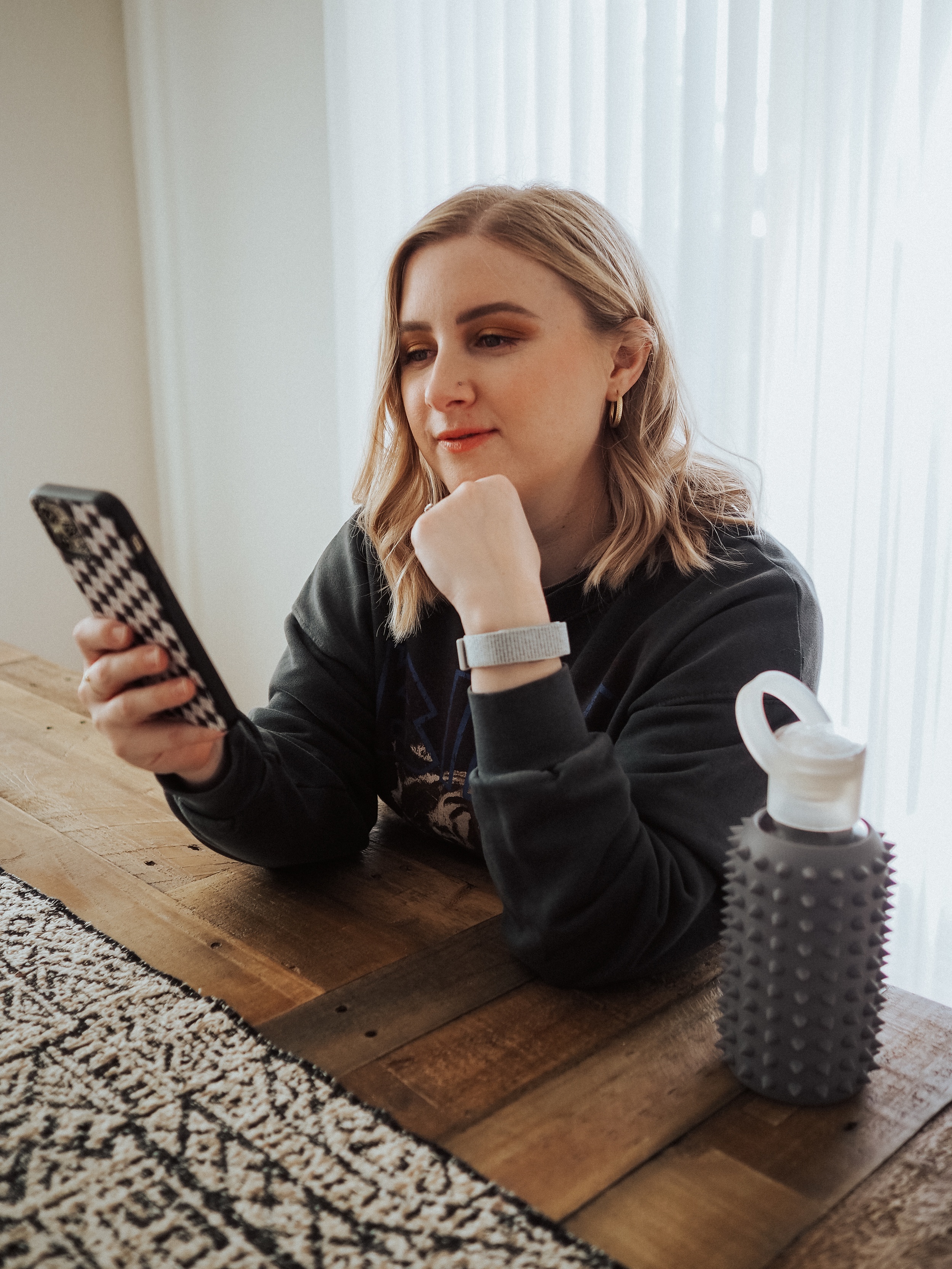
High level – what exactly is the Amazon Halo?
Amazon Halo is the latest in wellness wearables to hit the market. The device, as of the time of this blog post, is available to purchase “early access” only (updated 12/14 – I now see it’s available to purchase!). There is no announced release date at this time, as Amazon is likely wanting to utilize data collected from the early access period to help determine when Halo will launch to the greater public.
Functions of the Halo
Activity tracking
Like every fitness/wellness wearable out there, the Amazon Halo does track activity. Halo, though, does not necessarily track steps. Yes, you can totally see your step count – but steps aren’t the currency Amazon utilizes to determine your activity level. Halo instead tracks the intensity and duration of your movement plus sedentary time, more accurately painting a picture of your holistic activity level.
Honestly, I’m pretty on board with this activity tracking level-setting. Steps have frequently been utilized in fitness trackers as the main activity metric – not taking into account the intensity of said steps.
Body composition scans
Halo, utilizing the corresponding app, measures body fat percentage via a “scan.” The app even creates a personalized 3D model so you can view yourself at different body fat percentages. Halo utilizes body fat percentage as a key health metric over weight or BMI.
As a health coaching student, I’m acutely aware that weight and BMI can absolutely be 1) triggers for some and 2) an inaccurate picture of “health.” I do have to admit that I agree with Halo that body fat percentage is a better indicator of health than weight or BMI alone. “Health” or “wellness” is incredibly personal and neither weight nor BMI really tell the entire story when it comes to individual health.
While I do agree body fat percentage is a better metric than weight or BMI, it still isn’t perfect. Where that fat is being carried on the body may matter more than your percentage alone. Visceral fat one typically finds in the belly area is the real danger when it comes to things like risk for diabetes, heart disease, etc vs “butt fat.”
Sleep tracking and analysis
Halo can be worn to bed to analyze sleep patterns, like how often you wake up during the night. Sleep quality can impact a great deal including energy levels throughout the day, weight, mood, etc. Halo collects data while you sleep and can make recommendations as to how to improve your sleep quality over time.
“Labs”
The Halo app features “labs” – 100+ expert-developed Labs meant to test the impact small changes can have across your health. Labs include a wide variety of activities from at-home workouts, guided meditations, sleep sounds, and “other ways to stay healthy from experts like Lifesum, SWEAT, and Headspace.”
Tone analysis
Halo features built in microphones. When tone analysis is on (it’s optional!), Halo can analyze qualities of your voice like energy and positivity. The goal with tone analysis is to help the user strengthen communication – an interesting holistic wellness concept that goes beyond a standard “fitness” tracker.
Design & fit
At first glance the Halo may look similar to other wearables, but the key differentiator is the lack of a screen. Halo is screen-free intentionally – designed without a screen “for fewer distractions.” Halo isn’t meant to compete in design with a smart watch because it isn’t a watch, it’s essentially a wellness data collection device.
The Amazon Halo band options are fairly limited for now. There’s a fabric option and a “sport” option. The fabric sizes are Small (135-155 mm circumference), Medium (145-180mm circumference), and Large (170-220 mm circumference). The Sport sizes are Small/Medium (130-180 mm circumference) and Medium/Large (160-230 mm circumference). I purchased the fabric version in the color “Winter + Silver” in size Medium.
Amazon Halo battery life & durability
Halo boasts a battery life up to seven days with tone analysis disabled. With tone analysis running full time, you’ll be able to get approximately two days of battery life out of your device. Amazon also claims Halo fully charges from 0% in less than 90 minutes.
Any Amazon Halo waterproof claims are slightly misleading, because Amazon themselves only advertise Halo as “water resistant.” That being said – Amazon does list water resistance as up to 50M, which translates to 164 feet – much deeper than any casual swim would take you.
Device cost & subscription
Halo itself costs $99.99 (plus tax). The subscription to features within the Halo app will be free for six months (includes body composition, tone of voice analysis, sleep & activity tracking, and more) and then will automatically renew at $3.99/month plus applicable tax. If you choose not to continue your membership, you’ll retain access to basic sleep time, heart rate, and step tracking.

What makes Halo different?
Amazon Halo vs Fitbit
Real talk – I haven’t had a Fitbit in probably four or five years. When I did have a Fitbit, I absolutely loved it. Fitbit was my first introduction to wellness wearables. I loved the sleep tracking aspects of the Fitbit and did enjoy tracking both my steps and my heart rate.
A lot has changed with Fitbit since I last owned one of their devices. I can see they now advertise a Premium membership subscription, likely fairly similar to Halo’s (albeit more expensive at nearly $10 a month).
From what I can tell online, Fitbit does not focus on body fat percentage or do scans like Halo. If this is something you find interesting, Halo would be your best bet. I can also see that, from a design perspective, all Fitbit devices utilize screens.
Amazon Halo vs Apple Watch
Amazon Halo and Apple Watch aren’t at all comparable. Sure, they’re both wearables and sure, they can both tell you some of the same metrics – but Halo doesn’t seem to be positioning itself as a “smart watch” or even a particularly “smart wearable” like Apple Watch. As stated previously, Halo’s lack of screen is very intentional in that Amazon is saying notifications are distracting and not the purpose of their device. Halo can’t take calls, show you texts or calendar invites, or allow you to download other apps – and it wasn’t designed to do so.
If wellness related data is your mission – Halo would be the way to go. If you’re looking for a smart watch, I do own and like my Apple Watch. They’re just two different devices and while I can’t wear them both at the same time (or I could – but it would look ridiculous), they don’t compete with each other in terms of use case.
It’s also worth noting that in my own personal opinion, Apple Watch is severely lacking when it comes to health and wellness capabilities. Apple utilizes their “Health” app to track things like movement, heart rate, and blood oxygen, but has huge holes when it comes to potential. The Apple Watch battery life is so short it’s unlikely you’d be able to wear your watch throughout the day and then to bed to utilize sleep tracking. Apple Watch and the corresponding Health app also only contain surface level metrics and aren’t as comprehensive as those found using Halo. It was for these reasons exactly I was tempted, and took the plunge in purchasing Halo for myself even though I already own an Apple Watch.
Amazon Halo vs Whoop
Whoop is by far the most comparable product to the Amazon Halo in terms of design and data. Both products are essentially fitness and wellness data tracking “straps” that transmit daily data to a corresponding app. Both programs seem to capture similar data. The two key differentiators between Whoop and Halo are target market and price.
Whoop is very clearly being marketed to more “extreme” athletes or workout enthusiasts. Their website is packed with sexy black and white photos of weight lifting and running at warp speed. Amazon Halo’s cartoon-like instructional video is much more “wholesome” for lack of a better term. Amazon makes it clear the Halo is really for the every day person wanting to take small steps to be healthier – rather than a fitness junkie who also happens to be a data enthusiast.
The Whoop strap itself comes free with a membership (vs the Halo at the nearly $100 price point); however, Whoop monthly membership costs nearly 10x that of Halo.
If I were into fitness in any way, shape, or form, I might really appreciate Whoop’s focus on things like recovery time or strain. Personally I’m just a human who really wants to do a little better – and can’t stomach a price of $30ish a month to get access to the data I’m after.
Speaking of data…
Is my data safe with Halo?
I’m no privacy expert myself, but data privacy has become an increasingly hot topic in recent years. Amazon claims Halo has “multiple layers of privacy.” You can download or delete your data anytime and when it comes to your personally identifiable health data, no one will view it without your permission. Amazon also swears they’ll never sell your data.
If you choose to enable Tone, a voice profile is required and helps Halo analyze only your voice. You do have the option to turn the mics off at any time with the mute button on the band. In addition, your speech samples are deleted automatically after being processed so no one ever hears them.
In regards to Body Composition image, they’re processed in the cloud then automatically deleted so no one but you ever sees them.
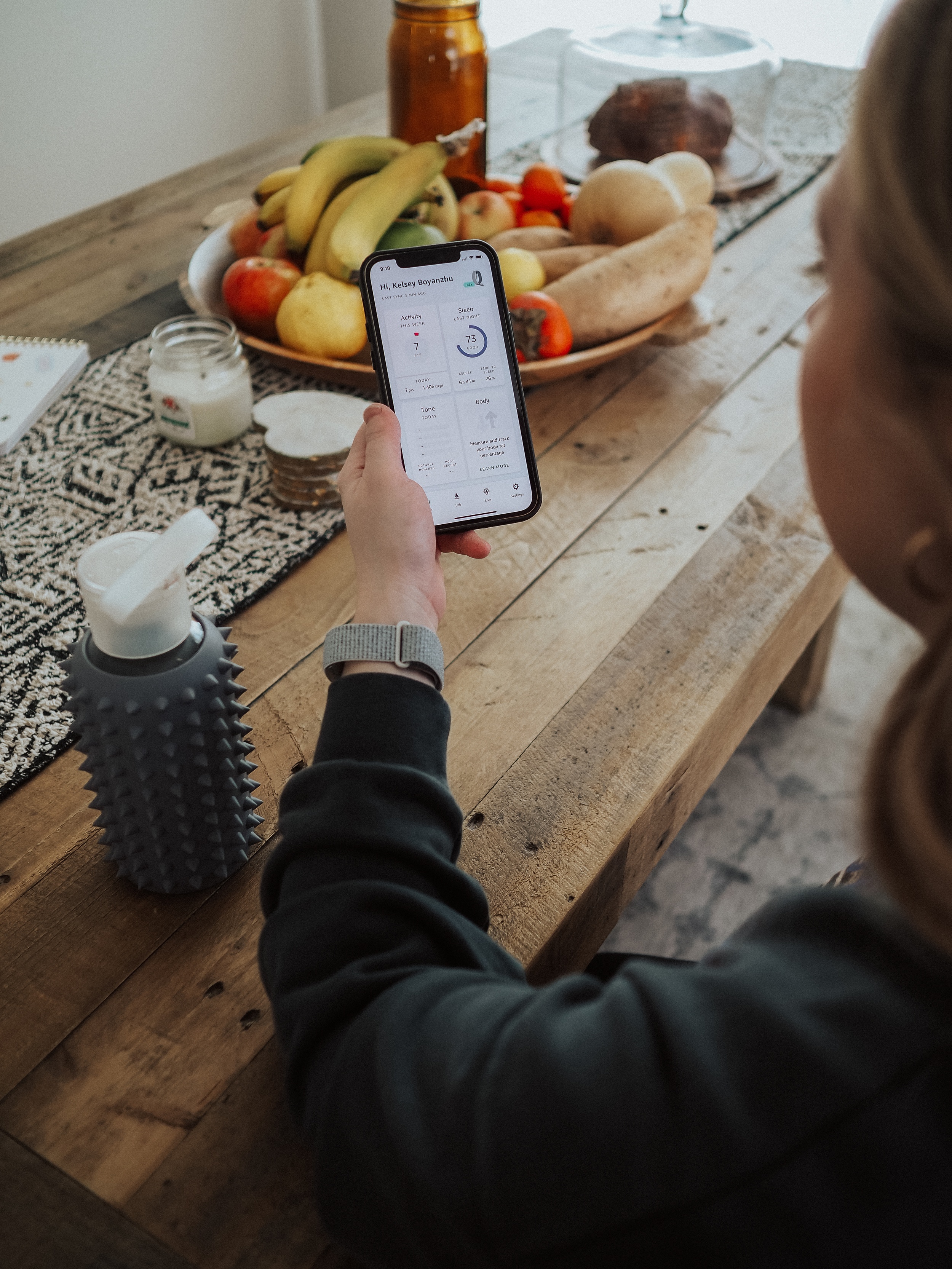
My personal experience using Halo.
Tracking my activity
I’m sure I’m not alone when I say the pandemic has turned my exercise world upside down. I mean – it turned my regular world upside down. But whatever good exercise habits I had established before quarantine flew out the window when my pilates studio closed and I started spending most of my day trapped indoors with all the snacks.
I’ve enjoyed tracking my activity with Halo because the app tracks activity utilizing a points system rather than steps – which is entirely new for me. In the past, I used to check apps like Apple’s Health app to see how many steps I was taking. Heck, steps were basically the main currency of Fitbit back in the day when I used Fitbit. While making sure I’m getting enough daily steps in is awesome, I do love that Halo sort of levels the playing field with points. I’m able to still get credit for other types of movement I may do (stretching, cycling, etc), and even am able to get credit for the intensity of the activity (light, moderate, or intense).
The real kicker? I’m pretty sure Halo takes away points for being sedentary for too long. LOLZ. So if you want to hit your points goal for the week, you not only have to make sure you get enough movement of a certain intensity level, but also keep an eye out that the amount of time you spend sitting around doesn’t count against you.
Basically this points system motivates me to take a midday walk during my lunch break. If Halo wants to take points away for every eight hours I spend sedentary, I can break up my work day with some quick movement and keep my points up!
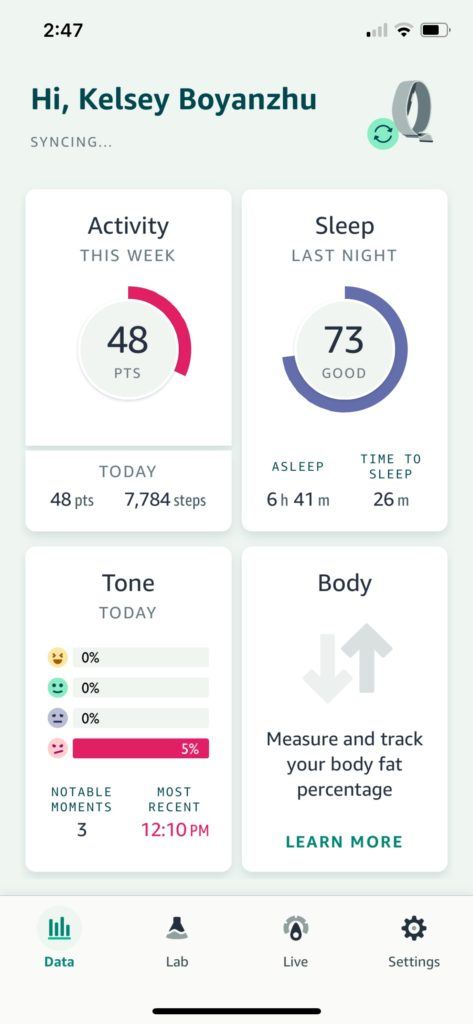
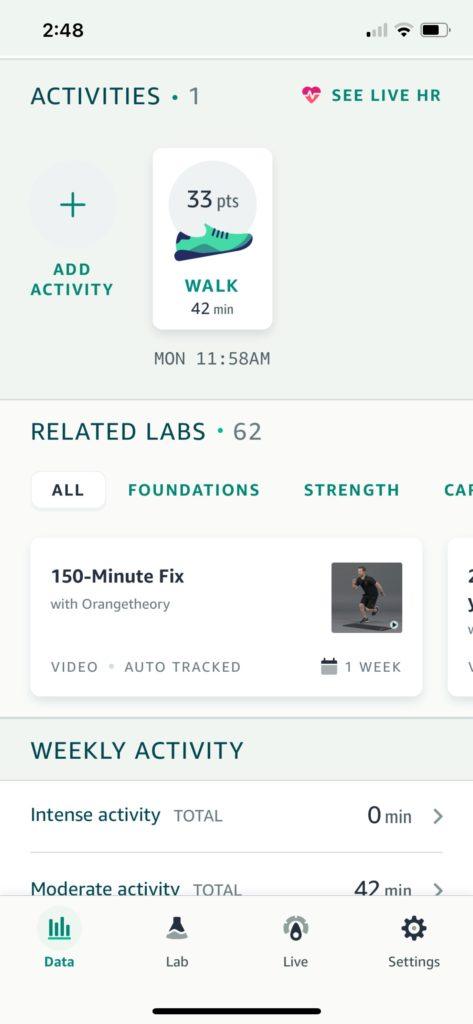
Tracking my sleep
I’ve never previously had much trouble with sleep, but 2020 threw me for a loop. I’ve actually developed a bit of sleep anxiety this year. Thanks a lot, Covid.
Basically all my anxiety about the “outside world” – doomsday headlines, scary disease, etc – has made me hyper paranoid of a home intruder. I’ve actually spent a lot of nights in 2020 staying up on gaurd against any impending doom. I get that it makes no sense, but I guess that’s just the reality of anxiety.
What I’ve found most interesting about tracking my sleep with Halo is that my actual sleep quality is no where near as bad as I thought it would be. It does sometimes take me a while to fall asleep, which I believe is a data point Halo misses, but once asleep my sleep quality is pretty great. This actually explains why, even though I have some late nights, I still feel rested the next day.
Like I said, the only data point here I feel needs some work is that “pre” sleep period. I’m not convinced Halo is accurately capturing the time I spend in bed awake, but trying to relax enough to get to sleep.
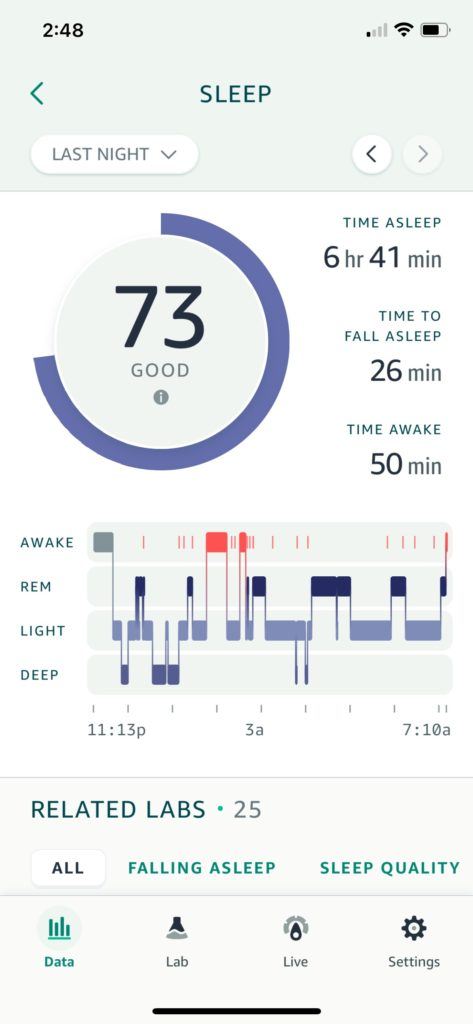
Fit, comfort, and aesthetics
Thinking back to my Fitbit days, wow did I have a LOT of wrist rashes. I frequently suffered from red, itchy skin under my Fitbit bands. I often tried to wear them more loosely to prevent any skin irritation, but they would flop around and feel like they weren’t secure. I had to resort to taking breaks from wearing my Fitbit to avoid the rashes. I speculate that the rubber band material was essentially trapping moisture underneath and causing irritation.
So far – knock on wood – I’ve had zero skin irritation from wearing my Amazon Halo. The fabric band is comfortable to wear and easy to adjust. Amazon recommends a fit that allows for two fingers to slip under the band. I find when wearing it per Amazon’s recommendation, the band feels secure, but not irritative.
My only gripe overall is that I just don’t find wearing this band all that attractive. It’s not terribly noticeable or offensive, but it isn’t exactly a fashion statement. I’m sure over time Amazon will release a wider selection of band options. For now, though, pickings are pretty slim and I’m not a huge fan of the options out there. It’s just a little MEH to wear beautiful jewelry you love, but then accent those higher end pieces with a fabric wellness band.
Not exactly a super chic look.
But all in all I think in this case, it really is about function over fashion. And the band itself isn’t a huge eyesore – it’s definitely much sleeker than my old OG big black bulky Fitbit.
Final thoughts
I’ve really enjoyed my time with the Amazon Halo. I do think Halo does a great job at arming the user with plenty of data to make health and wellness decisions – particularly when it comes to just raising overall user awareness to personal activity level and encouraging the user to incorporate more activity into daily life.
The reality is that I have barely scratched the surface of what I can do with my Halo. I have yet to make a habit out of trying all the cool “labs” inside the app. I also have yet to do a body scan (lolz I’m a little scared of my potential results). These items are on my list to try soon. But for now, I’m loving Halo as a daily activity and sleep tracker.
Tell me your thoughts on my Amazon Halo review! Do you have Halo? Let’s chat in the comments down below!

